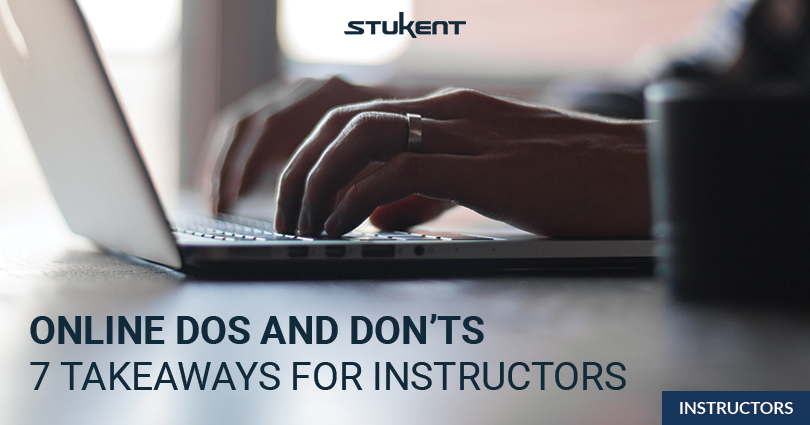As many have seen, moving from face-to-face (F2F) instruction to online-only delivery is possible — not necessarily easy, but achievable.
And amid this semester’s online learning adjustments and transitions, opportunities have emerged. Many instructors and students are positioned to experience how online approaches can help deliver engaging, educationally rich instruction.
As an instructor whose graduate work was completed mostly online, I have experience in how both F2F and online learning can take shape. Recognizing that both delivery methods have merit, I hope the following can bolster both those transitioned online due to COVID-19 concerns and those who were already teaching online.
Here are seven dos and don’ts to help you get online teaching right.

1. Do Put Content before Delivery
First, what do students need to learn? Then, what online delivery options will best present that content? The idea here is to not jump into all of the delivery options and technical aspects that are part of online instruction and try to make the content oblige. Don’t put the digital cart before the content horse, so to speak.
Educators know that how content is delivered makes a difference. But first comes content. Once it is determined what students need to know, the delivery mechanisms to best present that content can be designed and implemented.

2. Don’t Overwork Your Students
In an effort to keep students engaged, it can be easy to assign too much work and too many online tasks. There are so many ways that students can connect, participate, contribute, post, and acknowledge in online learning environments. Be realistic in how many ways students engage on assignments in your class and be sure of the educational benefits of them doing so.
Think of how credits earned in an online class align with the number of credits earned for a corresponding in-person class. What time expectations would you have for students to achieve success in a F2F section of your course? How does that time correlate to time expectations for an online section?

3. Do Keep Language Clear and Consistent
Word variation and synonym usage are great, but so is reader understanding. And in the case of online learning, reader understanding can save you and your students a lot of trouble.
Consider the value of clear and consistent language for navigating an online platform, remotely tackling a homework assignment, or trying to understand directions on an upcoming project (especially from a time zone or more away from an instructor). Also recognize that with distance education, communication between student and instructor may not have the benefit of nonverbal clues and rewording to support understanding.
Clarity
Use clear written and verbal instructions regarding parameters of student participation and performance. Be clear when it comes to coursework submission by providing instructions on due dates and times according to a specified time zone and clearly communicating what file types are acceptable.
Consistency
If a learning activity is called an assignment on the class calendar, that same activity should be called an assignment in the coursework queue, in written directions for completion and submission, in video instructions from you as the instructor, and anywhere else that assignment is referenced.
Be consistent with assignment due dates and submission requirements.

4. Don’t Disregard Audio
A great way to provide students with feedback is through audio recordings. You can talk to students collectively or individually, giving corrections and suggestions that students can listen to at times that work for them.
Leo Morejon spoke on the effectiveness of audio for student instruction during the Summer 2019 edition of the ongoing Stukent Digital Summit (SDS) virtual conference series. Leo is vice president of enablement at Build & Inspire and an Iowa State University and West Virginia University adjunct instructor.
As I wrote for a blog post recapping that SDS session, “While students may be paying attention, they are not really using their ears, [Leo] said, and spoke of providing a better educational experience than what is being offered in what he identifies as a text-saturated educational environment.
“That better educational experience, Leo said, is provided by using audio feedback to provide memorable feedback to students. For Leo, podcasting equipment for instructing online courses provided an avenue to connect with students. ‘They needed to hear me,’ he said.”
In his SDS presentation, Leo also pointed to students’ familiarity with voice-related technology and the efficiency that voice feedback provides instructors as reasons for incorporating audio into education.

5. Do Take a Student View
Open a student view of the online platform you are using and look at what your students are seeing. Does the assignment show up in the platform? Is assignment submission activated? Does the slide presentation open and does the link you included in the instructions work?
Take time to make sure course elements are in place and in working condition for your students. Making corrections to the presentation of materials and double checking that tools are activated may save students a lot of concern and you a lot of patch work, apology, and explanation.

6. Don’t Overlook What Is or Isn’t Going On
Instructors can take preliminary steps when it comes to this tip, but awareness during the semester is also encouraged.
What Is Going On
Online classes give students a level of anonymity and distance that can be used negatively. Not having to face one another in person may heighten the use of aggressive responses and harsh comments. I remind students that online bullying and unprofessional behavior can affect them personally and educationally.
Consider what could help eliminate, reduce, or handle bullying and/or unprofessional communication by establishing rules and expectations at the onset of the course.
You’ll also want to be aware of and stop unacceptable communication that does occur in an online learning environment.
What Isn’t Going On
This is a reminder to notice a lack of participation among students. Who is not commenting, posting, or handing in assignments? Who is not spending much time in the course platform? Reaching out to students early in their non- or limited participation may make a big difference for them individually and save a lot of avoidable educational strain later in the semester.

7. Do Communicate Expectations
Let students know when and how often to expect communication from you. Let them know what constitutes “participation” throughout the semester. And let them know what to do if technology issues arise. Consider how much you can or want to take on when it comes to technical trouble-shooting or otherwise providing technical support for students. Directing students to your institution’s technical support services may save you from becoming your class IT department.
Overall, take a proactive role in communicating expectations.
FOR ADDITIONAL RESOURCES
Check out this collection of online teaching resources. It includes content referenced during Stukent’s “How to Transition Your Course to Online” webinar.






